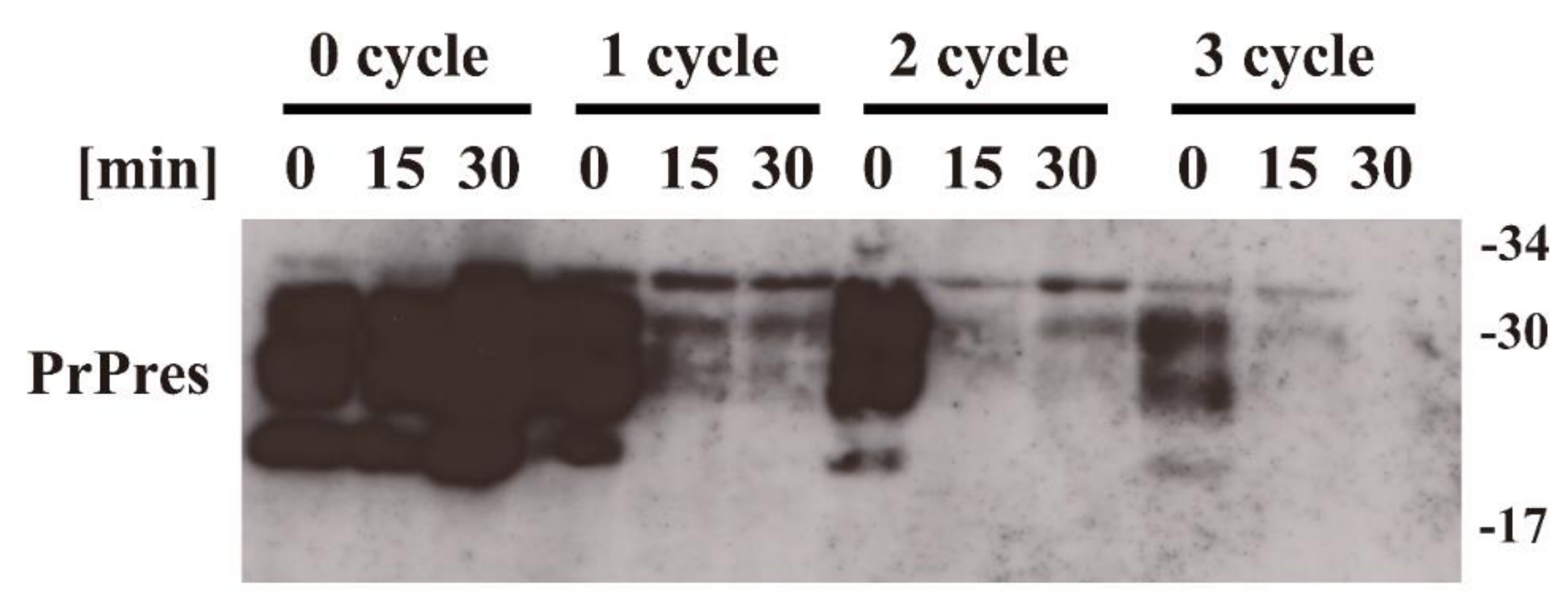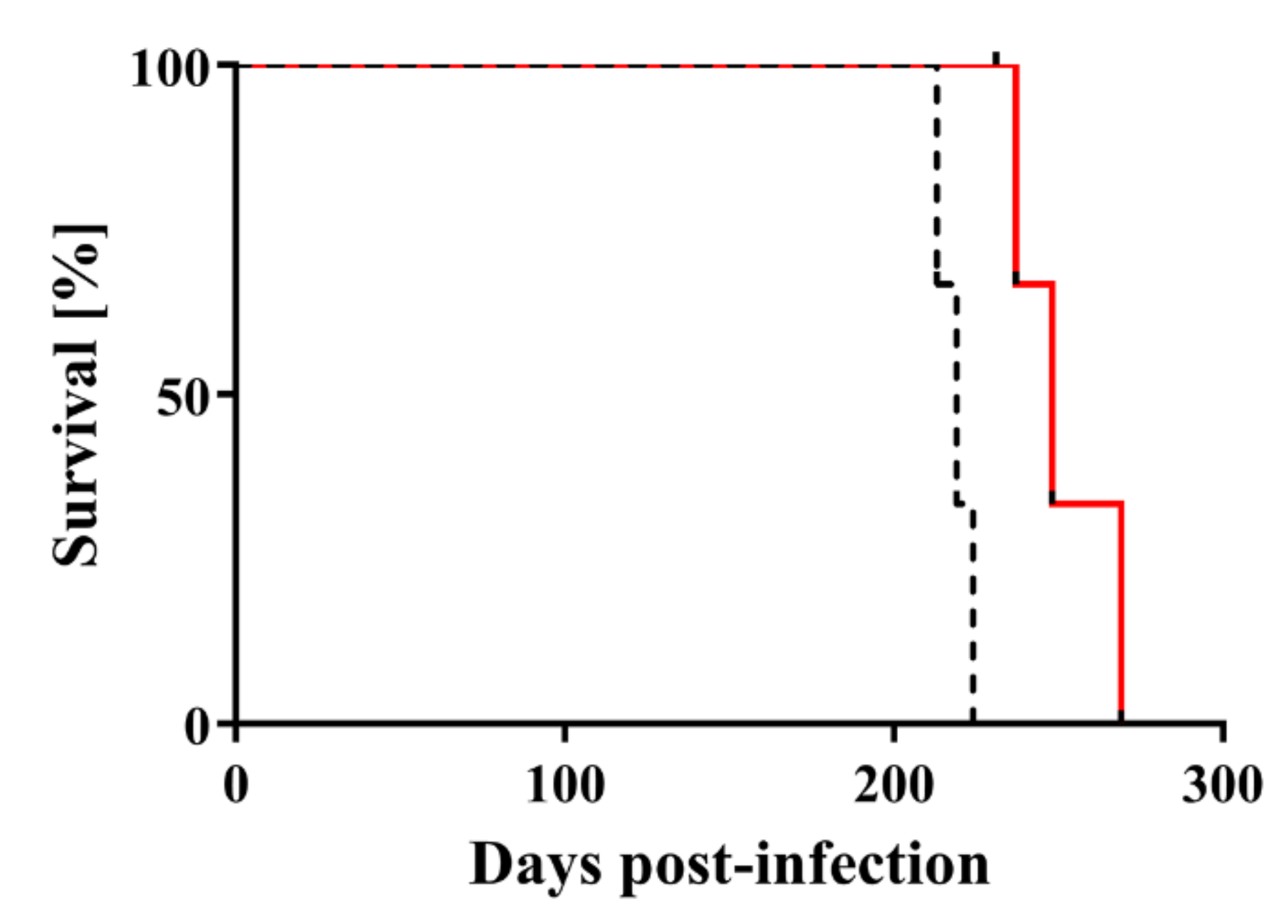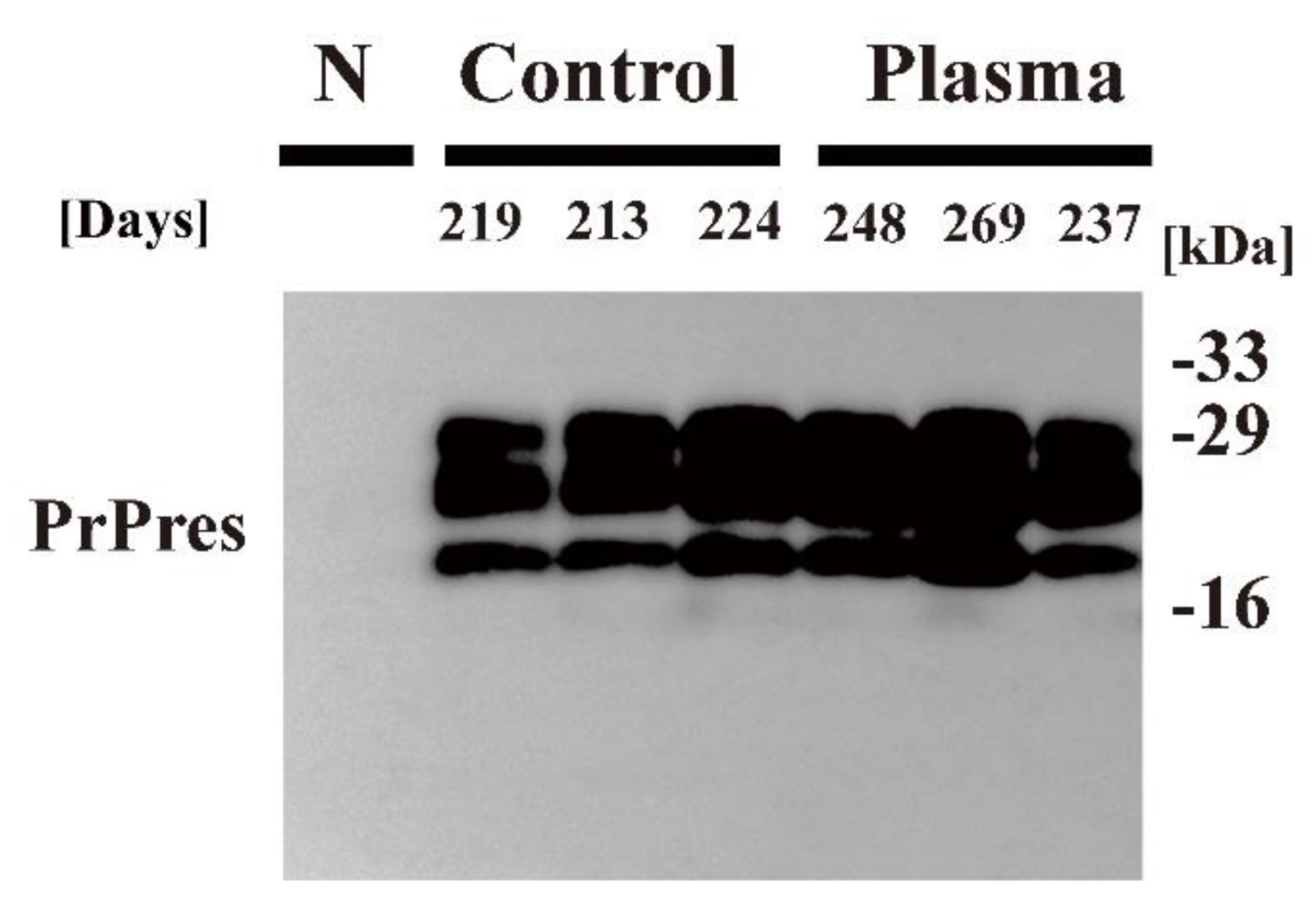Effect of Nitrogen Gas Plasma Generated by a Fast-Pulsed Power Supply Using a Static Induction Thyristor on Scrapie Prion
Abstract
1. Introduction
2. Results
2.1. Nitrogen Gas Plasma Treatment of Scrapie Prion Reduced Prion Amplification In Vitro
2.2. Nitrogen Gas Plasma Treatment Reduced Prion Infectivity in a Mouse Bioassay
3. Discussion
4. Materials and Methods
4.1. Nitrogen Gas Plasma Device
4.2. PMCA
4.3. Western Blot Analysis
4.4. Prion Inoculation
4.5. Histopathology and Immunohistochemistry
4.6. Statistical Analysis
Author Contributions
Funding
Acknowledgments
Conflicts of Interest
References
- Prusiner, S.B. Prions. Proc. Natl. Acad. Sci. USA 1998, 95, 13363–13383. [Google Scholar] [CrossRef] [PubMed]
- Prusiner, S.B. Molecular biology of prion diseases. Science 1991, 252, 1515–1522. [Google Scholar] [CrossRef] [PubMed]
- Sakudo, A.; Ikuta, K. Prion protein functions and dysfunction in prion diseases. Curr. Med. Chem. 2009, 16, 380–389. [Google Scholar] [CrossRef] [PubMed]
- Baral, P.K.; Yin, J.; Aguzzi, A.; James, M.N.G. Transition of the prion protein from a structured cellular form (PrPC)) to the infectious scrapie agent (PrPSc). Protein Sci. 2019, 28, 2055–2063. [Google Scholar] [CrossRef]
- Pan, K.M.; Baldwin, M.; Nguyen, J.; Gasset, M.; Serban, A.; Groth, D.; Mehlhorn, I.; Huang, Z.; Fletterick, R.J.; Cohen, F.E.; et al. Conversion of alpha-helices into beta-sheets features in the formation of the scrapie prion proteins. Proc. Natl. Acad. Sci. USA 1993, 90, 10962–10966. [Google Scholar] [CrossRef]
- Cohen, F.E.; Prusiner, S.B. Pathologic conformations of prion proteins. Annu. Rev. Biochem. 1998, 67, 793–819. [Google Scholar] [CrossRef]
- Castilla, J.; Saa, P.; Morales, R.; Abid, K.; Maundrell, K.; Soto, C. Protein misfolding cyclic amplification for diagnosis and prion propagation studies. Methods Enzymol. 2006, 412, 3–21. [Google Scholar] [CrossRef]
- Soto, C.; Saborio, G.P.; Anderes, L. Cyclic amplification of protein misfolding: Application to prion-related disorders and beyond. Trends Neurosci. 2002, 25, 390–394. [Google Scholar] [CrossRef]
- Giaccone, G.; Moda, F. PMCA Applications for prion detection in peripheral tissues of patients with variant Creutzfeldt-Jakob disease. Biomolecules 2020, 10, 405. [Google Scholar] [CrossRef]
- Sakudo, A. Inactivation methods for prions. Curr. Issues Mol. Biol. 2020, 36, 23–32. [Google Scholar] [CrossRef]
- Sakudo, A.; Ano, Y.; Onodera, T.; Nitta, K.; Shintani, H.; Ikuta, K.; Tanaka, Y. Fundamentals of prions and their inactivation (review). Int J. Mol Med. 2011, 27, 483–489. [Google Scholar] [CrossRef] [PubMed]
- Fichet, G.; Comoy, E.; Duval, C.; Antloga, K.; Dehen, C.; Charbonnier, A.; McDonnell, G.; Brown, P.; Lasmezas, C.I.; Deslys, J.P. Novel methods for disinfection of prion-contaminated medical devices. Lancet 2004, 364, 521–526. [Google Scholar] [CrossRef]
- Rutala, W.A.; Weber, D.J. Society for Healthcare Epidemiology of, A. Guideline for disinfection and sterilization of prion-contaminated medical instruments. Infect. Control. Hosp. Epidemiol. 2010, 31, 107–117. [Google Scholar] [CrossRef]
- Jacobs, P.T.; Lin, S.M. Hydrogen peroxide plasma sterilization system. U.S. Patent 4,756,882, 27 January 1987. [Google Scholar]
- Moulton, K.A.; Campbell, B.A.; Caputo, R.A. Plasma Sterilizing Process with Pulsed Antimicrobial Agent. U.S. Patent 5,084,239, 31 August 1990. [Google Scholar]
- Finnegan, M.; Linley, E.; Denyer, S.P.; McDonnell, G.; Simons, C.; Maillard, J.Y. Mode of action of hydrogen peroxide and other oxidizing agents: Differences between liquid and gas forms. J. Antimicrob. Chemother. 2010, 65, 2108–2115. [Google Scholar] [CrossRef] [PubMed]
- FDA Talk Paper No.T98-17; FDA US Department of Health and Human Services: Fishers Lane Rockville, MD, USA, 1998. Available online: https://www.fda.gov/bbs/topics/ANSWERS/ANS00860.html (accessed on 1 September 2019).
- Gibbs, J.; Matthees, S.; UBM Americas; UBM plc Company. Lessons Learned from the AbTox Ruling. Available online: https://www.mddionline.com/lessons-learned-abtox-ruling (accessed on 1 September 2008).
- Furuhata, S.; Nishimura, C.; Furuhashi, N.; Miyakawa, J.; Ozawa, M.; Usami, K.; Misawa, A.; Karasawa, H. Effectiveness test of low temperature plasma sterilization method using peracetic acid and hydrogen peroxide (in Japanese). Jpn. J. Assoc. Op. Med. 2000, 21, 140–144. [Google Scholar]
- Shintani, H.; Shimizu, N.; Imanishi, Y.; Sekiya, T.; Tamazawa, K.; Taniguchi, A.; Kido, N. Inactivation of microorganisms and endotoxins by low temperature nitrogen gas plasma exposure. Biocontrol Sci. 2007, 12, 131–143. [Google Scholar] [CrossRef][Green Version]
- Sakudo, A.; Misawa, T.; Shimizu, N.; Imanishi, Y. N2 gas plasma inactivates influenza virus mediated by oxidative stress. Front. Biosci. 2014, 6, 69–79. [Google Scholar] [CrossRef] [PubMed]
- Sakudo, A.; Toyokawa, Y.; Nakamura, T.; Yagyu, Y.; Imanishi, Y. Nitrogen gas plasma treatment of bacterial spores induces oxidative stress that damages the genomic DNA. Mol. Med. Rep. 2017, 15, 396–402. [Google Scholar] [CrossRef] [PubMed]
- Sakudo, A.; Toyokawa, Y.; Imanishi, Y.; Murakami, T. Crucial roles of reactive chemical species in modification of respiratory syncytial virus by nitrogen gas plasma. Mater. Sci. Eng. C 2017, 74, 131–136. [Google Scholar] [CrossRef] [PubMed]
- Sakudo, A.; Toyokawa, Y.; Imanishi, Y. Nitrogen gas plasma generated by a static induction thyristor as a pulsed power supply inactivates adenovirus. PLoS ONE 2016, 11, e0157922. [Google Scholar] [CrossRef]
- Sakudo, A.; Shimizu, N.; Imanishi, Y.; Ikuta, K. N2 gas plasma inactivates influenza virus by inducing changes in viral surface morphology, protein, and genomic RNA. Biomed. Res. Int. 2013, 2013, 694269. [Google Scholar] [CrossRef] [PubMed]
- Jacobs, P.T.; Lin, S.M. Hydrogen Peroxide Plasma Sterilization System. U.S. Patent 4,643,876, 21 June 1985. [Google Scholar]
- Krebs, M.C.; Bécasse, P.; Verjat, D.; Darbord, J.C. Gas plasma sterilization: Relative efficacy of the hydrogen peroxide phase compared with that of the plasma phase. Int. J. Pharm. 1998, 160, 75–81. [Google Scholar] [CrossRef]
- Sakudo, A.; Yagyu, Y.; Onodera, T. Disinfection and sterilization using plasma technology: Fundamentals and future perspectives for biological applications. Int. J. Mol. Sci. 2019, 20, 5216. [Google Scholar] [CrossRef]
- Julák, J.; Janoušková, O.; Scholtz, V.; Holada, K. Inactivation of prions using electrical DC discharges at atmospheric pressure and ambient temperature. Plasma Process. Polym. 2011, 8, 316–323. [Google Scholar] [CrossRef]
- Baxter, H.C.; Campbell, G.A.; Whittaker, A.G.; Jones, A.C.; Aitken, A.; Simpson, A.H.; Casey, M.; Bountiff, L.; Gibbard, L.; Baxter, R.L. Elimination of transmissible spongiform encephalopathy infectivity and decontamination of surgical instruments by using radio-frequency gas-plasma treatment. J. Gen. Virol. 2005, 86, 2393–2399. [Google Scholar] [CrossRef]
- Von Keudell, A.; Awakowicz, P.; Benedikt, J.; Raballand, V.; Yanguas-Gil, A.; Opretzka, J.; Flötgen, C.; Reuter, R.; Byelykh, L.; Halfmann, H.; et al. Inactivation of bacteria and biomolecules by low-pressure plasma discharges. Plasma Process. Polym. 2010, 7, 327–352. [Google Scholar] [CrossRef]
- Roth, S.; Feichtinger, J.; Hertel, C. Characterization of Bacillus subtilis spore inactivation in low-pressure, low-temperature gas plasma sterilization processes. J. Appl. Microbiol. 2010, 108, 521–531. [Google Scholar] [CrossRef]
- Sakudo, A.; Higa, M.; Maeda, K.; Shimizu, N.; Imanishi, Y.; Shintani, H. Sterilization mechanism of nitrogen gas plasma: Induction of secondary structural change in protein. Microbiol. Immunol. 2013, 57, 536–542. [Google Scholar] [CrossRef] [PubMed]
- Pattison, I.H. The relative susceptibility of sheep, goats and mice to two types of the goat scrapie agent. Res. Vet. Sci. 1966, 7, 207–212. [Google Scholar] [CrossRef]
- Prusiner, S.B.; Cochran, S.P.; Groth, D.F.; Downey, D.E.; Bowman, K.A.; Martinez, H.M. Measurement of the scrapie agent using an incubation time interval assay. Ann. Neurol. 1982, 11, 353–358. [Google Scholar] [CrossRef]
- Derkinderen, P. Could it be that neurodegenerative diseases are infectious? Rev. Neurol. 2019, 175, 427–430. [Google Scholar] [CrossRef] [PubMed]
- Kovacs, G.G. Molecular pathology of neurodegenerative diseases: Principles and practice. J. Clin. Pathol. 2019, 72, 725–735. [Google Scholar] [CrossRef] [PubMed]
- Jaunmuktane, Z.; Brandner, S. Invited Review: The role of prion-like mechanisms in neurodegenerative diseases. Neuropathol. Appl. Neurobiol. 2019. [Google Scholar] [CrossRef] [PubMed]
- Prusiner, S.B. Cell biology. A unifying role for prions in neurodegenerative diseases. Science 2012, 336, 1511–1513. [Google Scholar] [CrossRef] [PubMed]
- Marin-Moreno, A.; Aguilar-Calvo, P.; Moudjou, M.; Espinosa, J.C.; Beringue, V.; Torres, J.M. Thermostability as a highly dependent prion strain feature. Sci. Rep. 2019, 9, 11396. [Google Scholar] [CrossRef]
- Murayama, Y.; Yoshioka, M.; Yokoyama, T.; Iwamaru, Y.; Imamura, M.; Masujin, K.; Yoshiba, S.; Mohri, S. Efficient in vitro amplification of a mouse-adapted scrapie prion protein. Neurosci. Lett. 2007, 413, 270–273. [Google Scholar] [CrossRef]
- Sakudo, A.; Lee, D.C.; Saeki, K.; Matsumoto, Y.; Itohara, S.; Onodera, T. Tumor necrosis factor attenuates prion protein-deficient neuronal cell death by increases in anti-apoptotic Bcl-2 family proteins. Biochem. Biophys. Res. Commun. 2003, 310, 725–729. [Google Scholar] [CrossRef]
- Sakudo, A.; Onodera, T.; Ikuta, K. PrPSc level and incubation time in a transgenic mouse model expressing Borna disease virus phosphoprotein after intracerebral prion infection. Neurosci. Lett. 2008, 431, 81–85. [Google Scholar] [CrossRef]
- Inoue, Y.; Yamakawa, Y.; Sakudo, A.; Kinumi, T.; Nakamura, Y.; Matsumoto, Y.; Saeki, K.; Kamiyama, T.; Onodera, T.; Nishijima, M. Infection route-independent accumulation of splenic abnormal prion protein. Jpn. J. Infect. Dis. 2005, 58, 78–82. [Google Scholar]






| Nitrogen Gas Plasma Treatment Time | Mean Incubation Time ± SEM 1 |
|---|---|
| 0 min | 218.7 ± 3.2 days |
| 30 min | 251.3 ± 9.4 days 2 |
| Nitrogen Gas Plasma Treatment Time | Vacuoles in Brain | PrPSc Accumulation in Brain |
|---|---|---|
| 0 min | +++ | ++ |
| 30 min | + | ++ |
© 2020 by the authors. Licensee MDPI, Basel, Switzerland. This article is an open access article distributed under the terms and conditions of the Creative Commons Attribution (CC BY) license (http://creativecommons.org/licenses/by/4.0/).
Share and Cite
Sakudo, A.; Imanishi, Y.; Hirata, A.; Koga, Y.; Shintani, H. Effect of Nitrogen Gas Plasma Generated by a Fast-Pulsed Power Supply Using a Static Induction Thyristor on Scrapie Prion. Pathogens 2020, 9, 819. https://doi.org/10.3390/pathogens9100819
Sakudo A, Imanishi Y, Hirata A, Koga Y, Shintani H. Effect of Nitrogen Gas Plasma Generated by a Fast-Pulsed Power Supply Using a Static Induction Thyristor on Scrapie Prion. Pathogens. 2020; 9(10):819. https://doi.org/10.3390/pathogens9100819
Chicago/Turabian StyleSakudo, Akikazu, Yuichiro Imanishi, Azumi Hirata, Yuichi Koga, and Hideharu Shintani. 2020. "Effect of Nitrogen Gas Plasma Generated by a Fast-Pulsed Power Supply Using a Static Induction Thyristor on Scrapie Prion" Pathogens 9, no. 10: 819. https://doi.org/10.3390/pathogens9100819
APA StyleSakudo, A., Imanishi, Y., Hirata, A., Koga, Y., & Shintani, H. (2020). Effect of Nitrogen Gas Plasma Generated by a Fast-Pulsed Power Supply Using a Static Induction Thyristor on Scrapie Prion. Pathogens, 9(10), 819. https://doi.org/10.3390/pathogens9100819





